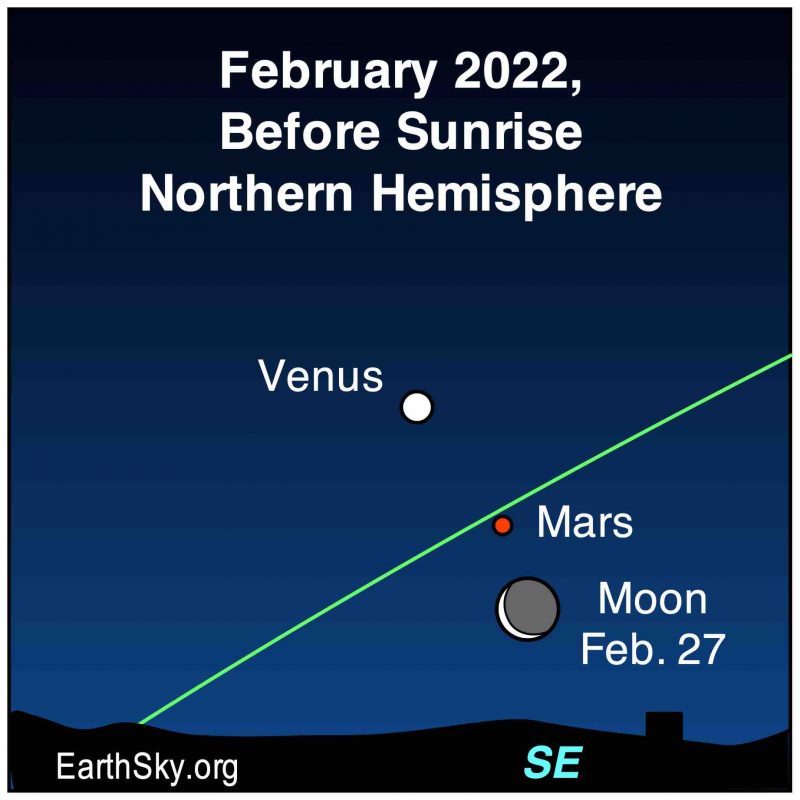
Planets and the moon
Early risers have the advantage in planet-observing in late February, 2022, with some beautiful views in the east before sunrise. On February 27, shining Venus, faint Mars and a crescent moon will stand top-to-bottom in a nearly vertical line in the sunrise direction. Two other planets – Saturn and Mercury – are there, too, hiding in the sunrise glare for Northern Hemisphere viewers. But you can probably see them from the Southern Hemisphere, especially on the morning of February 28, when the moon will be an even thinner crescent, closer to the sunrise.
The moon’s closest approach to Mars is on February 27 at 11 UTC or 5 a.m. CST. At that time the moon will be 3.5 degrees southeast of Mars. Mars will be shining faintly at magnitude 1.3. Venus is a brilliant magnitude -4.6.
If you start looking early enough before sunrise, while the sky is still relatively dark, you’ll see the stars surrounding these newly risen planets. The trio of Venus, Mars and the moon are in front of the constellation Sagittarius. Sagittarius’s asterism of the Teapot is just to the right of the line of planets. The trio lies close to where we see the starry band of the Milky Way running across a dark sky. And indeed the constellation Sagittarius marks the direction to gaze toward the Milky Way’s center.
The 2022 lunar calendars are still available. Order yours before they’re gone!

The moon meets two other planets on February 28
On February 27, from Northern Hemisphere locations, will you also see Saturn and Mercury? They are east of the trio and rise after the Venus-Mars-moon trio completely clears the horizon (see the chart below) and will be much more visible from Earth’s Southern Hemisphere than from Northern Hemisphere locations. Shortly after all four planets rise, the sun crests the horizon even farther to the east, overwhelming the light from the planets.
On the morning of February 28, the moon swings eastward, too, and appears closer to the planets Mercury and Saturn. But, for the Northern Hemisphere, this trio will be difficult (or impossible) to spot because they rise later, closer to dawn. The sliver-thin crescent moon will be very difficult as well on the morning of February 28, shining at only around 6% illumination. New moon will follow about two days later.
The moon’s closest approach to Mercury is on February 28 at 23 UTC or 5 p.m. CST. But the planets aren’t above the horizon at 5 p.m. CST! That’s okay. It just means they won’t be quite that close together when you see them. The moon will be 3.6 degrees southeast of magnitude -0.1 Mercury. And Saturn is dimmer at magnitude 0.8.

Bottom line: The crescent moon meets up with planetary pairs in late February 2022. First it pulls alongside Venus and Mars on the morning of February 27. And then it meets Saturn and Mercury in the glow of dawn on February 28. Saturn and Mercury are difficult or impossible to see from the Northern Hemisphere, but Southern Hemisphere stargazers can pick them up.
The post Planets and the moon, February 27 (and 28) mornings first appeared on EarthSky.
0 Commentaires